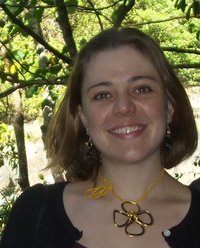Arielle Cooley: Difference between revisions
| Line 26: | Line 26: | ||
==Publications== | ==Publications== | ||
'''Cooley, A.M.''', J.L. Modlizewski, M.L. Rommel, and J.H. Willis (in prep). Independent changes | '''Cooley, A.M.''', J.L. Modlizewski, M.L. Rommel, and J.H. Willis (in prep). The importance of MYBs: Independent regulatory changes cause parallel evolution of flower color in ''Mimulus''. | ||
Wittkopp, P.W., G. Smith-Winberry, L.L. Arnold, E.M. Thompson, '''A.M. Cooley''', D.C. Yuan, Q. Song, and B.F. McAllister (2010). Local adaptation for body color in Drosophila americana. ''Heredity''. Advance Online Publication. DOI: 10.1038/hdy.2010.90 | Wittkopp, P.W., G. Smith-Winberry, L.L. Arnold, E.M. Thompson, '''A.M. Cooley''', D.C. Yuan, Q. Song, and B.F. McAllister (2010). Local adaptation for body color in Drosophila americana. ''Heredity''. Advance Online Publication. DOI: 10.1038/hdy.2010.90 | ||
Revision as of 12:54, 7 August 2010

About Me
I am a recent graduate of John Willis' lab. There I worked primarily on the genetics of floral pigment patterning in a group of monkeyflowers (Mimulus) from the foothills of the Chilean Andes. I am now beginning a post doc at the University of Michigan, in Trisha Wittkopp's lab. I am still studying the evolution of color patterning, but in a rather different system:

.
Contact Info
Arielle Cooley University of Michigan Ecology and Evolutionary Biology Dept Wittkopp Lab Ann Arbor, MI 48109 Email: acooley@gmail.com
My Graduate Research

Mimulus luteus var. luteus, M. l. variegatus, M. naiandinus and M. cupreus are four closely related members of the genus Mimulus that differ dramatically in the distribution of a red anthocyanin pigment, cyanidin, in their floral tissues (Fig. 1). This pattern variation is phylogenetically unique: the study taxa belong to a large monophyletic group in which virtually all of the other ~40 species have remarkably constant corolla pigmentation (yellow with red spots along the throat). My thesis has focused on the following questions:
- Is there evidence of pollinator-mediated reproductive isolation among floral types?
- Are pigment patterning differences, both within and between species, simple or quantitative?
- What is the identity of the pigment patterning genes?
- Are the functional changes structural or regulatory?
- Is there evidence of convergent evolution (are distinct genetic mechanisms responsible for similar phenotypes)?
Publications
Cooley, A.M., J.L. Modlizewski, M.L. Rommel, and J.H. Willis (in prep). The importance of MYBs: Independent regulatory changes cause parallel evolution of flower color in Mimulus.
Wittkopp, P.W., G. Smith-Winberry, L.L. Arnold, E.M. Thompson, A.M. Cooley, D.C. Yuan, Q. Song, and B.F. McAllister (2010). Local adaptation for body color in Drosophila americana. Heredity. Advance Online Publication. DOI: 10.1038/hdy.2010.90
Cooley, A.M., and J.H. Willis (2009). Genetic divergence causes parallel evolution of flower color in Chilean Mimulus. New Phytologist 183: 729-739. Special Issue: “Plant Adaptation: Following in Darwin’s Footsteps”. PDF
Cooley, A.M., G. Carvallo, and J.H. Willis (2008). Is floral diversification associated with pollinator divergence? Flower shape, flower colour, and pollinator preference in Chilean Mimulus. Annals of Botany 101: 641-650. PDF
Wu, C.A., D.B. Lowry, A.M. Cooley, K.M. Wright, Y.-W. Lee, and J.H. Willis (2008). Mimulus is an emerging model system for the integration of ecological and genomic studies. Heredity 100: 220-230.
Cooley, A.M., A. Reich, and P. Rundel (2004). Leaf support biomechanics of neotropical understory herbs. American Journal of Botany 91: 573-581.
Funding sources
NIH Ruth Kirschstein Award (NRSA), 1 F32 GM087928-01
NSF Predoctoral Award, #338-0098
NSF Doctoral Dissertation Improvement Grant, #0508732
Duke University Biology Department
Fun Stuff
Field work in Chile
Salsa dancing in the Triangle